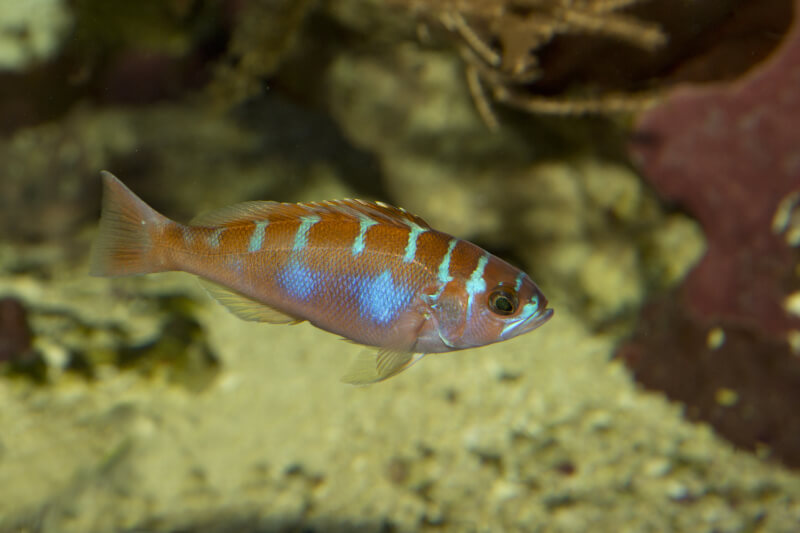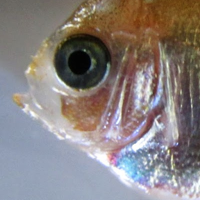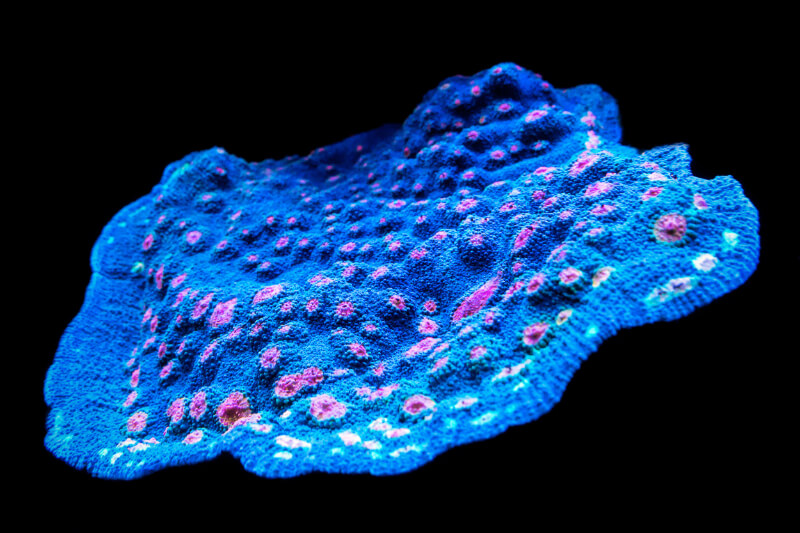Quick Facts
| Scientific Name: | Serranus tortugarum |
| Other Names: | Chalk Basslets |
| Reef Safe: | Yes |
| Lifespan: | 1-2 years |
| Size: | 2-3 inches |
| Care: | Easy |
| Diet: | Omnivores eating algae, zooplankton |
| Water Parameters: | 72°F to 76°F, 8.1 to 8.4pH, 8 to 12 dKH, 1.020 to 1.025SG |
| Tank Size: | 30 gallons |
| Behavior: | Paceful |
| Breeding Difficulty: | Medium to High since they are hermaphrodites |
There is a lot to learn about the Chalk Bass and we summarized the most important here in this guide.
This fish has an interesting social behavior, usually forming small groups or pairs which makes it important when looking for tank mates.
The Chalk Basslet can be both male and female which is kinda cool, isn’t it? This and other essential facts are covered in our care guide so you can succeed with this new friend in your tank.
Ready? Let’s do this!
Species Summary
The Chalk Bass, or Serranus tortugarum, is an underrated saltwater fish that’s not often picked by hobbyists due to its muted colors. However, just because they don’t stand out doesn’t mean you want to miss out on this hardy, peaceful and charming vertebrate.
Chalk Basslets are native to the Western Atlantic, with many sticking around the Caribbean Islands and the east coast of Florida.
It’s not uncommon to encounter large schools of these camouflaging fish around Honduras or the Bahamas. Due to their small size, they typically prefer to hide out around the ocean floor. While they have been found as deep as 1,300 feet, many thrive in the area between 30 to 300 feet.
Author Note: These social creatures are affordable and work great in community tanks of varying sizes. They’re typically easy to care for, but you still need to maintain a healthy environment to protect their beautiful coloring and health.
Appearance
As these fish can change their scale pigmentation to match their environment, it’s often difficult to accurately describe them. Chalk Bass traditionally have barrel-like orange bodies with eye-catching stripes of blue.
You may also see a Chalk Basslet with a pale blue body and purple, black or deep red stripes that extend to their dorsal fins. Your tank lighting and design will have a huge impact on your new fish’s day-to-day appearance.
Lifespan
Unfortunately, the lifespan of the chalk bass is only about 1 to 2 years. They grow and reach adulthood fast, but you’ll have to frequently replenish their population in your aquarium.
Average Size
The average length for a Chalk Bass is between 2 to 3 inches. It’s possible but rather rare to see your mature basslet reach four inches long.
Chalk Bass Care
The best way to protect your Chalk Bass’ health is to mimic its natural Caribbean environment. These fish are perfect for beginners with smaller, well-decorated tanks.
Excellent nutrition, peaceful tank mates and a varied environment are all essential to giving your Chalk Basslet an enriched and healthy life.
Tank Size
The minimum recommended tank size for Chalk Bass is 30 gallons. However, as this is a type of schooling fish, you may want to have at least three or so in one aquarium. It’s best to provide at least 15 to 20 gallons per fish, so they have plenty of swimming space as well as hiding areas.
Author Note: While they can be safely held in nano tanks, not providing enough room could lead to aggression issues as well as stress.
What To Put In Their Tank
In the wild, these small vertebrates hover near the substrate to ensure they have easy access to nearby rocks, ledges and caves. Their small size makes them the perfect snack for bigger fish, which is why they must be able to dash into safety.
Decorate your aquarium with plenty of live rock, structures and holes where they can retreat. After acclimating to your tank, your Chalk Basslet will likely claim one specific area as its “home”.
Feel free to add large shells or charming coral rubble to make the environment more appealing to them. When you first add your Chalk Bass, you’ll want to keep the lights on a lower setting to promote a calmer acclimation process.
Once they’re more comfortable, you can return your lighting to its standard settings.
Author Note: When these fish feel threatened or cornered, they can jump to try to escape. Secure your aquarium with a tight lid or mesh top to prevent any unfortunate carpet surfing.
Water Parameters
Water temperature: 72°F to 76°F
pH levels: 8.1 to 8.4
Water hardness: 8 to 12 dKH
Specific gravity: 1.020 to 1.025

Are Chalk Bass Reef Safe?
Chalk Basslets are generally accepted as reef-safe fish. They may graze around your prized corals and polyps, but they shouldn’t otherwise nip or harm them.
It’s also important to note that while these fish won’t typically bother their tank mates, the large adults may be interested in eating your decorative shrimp. This usually doesn’t happen unless your basslet doesn’t have easy access to other food.
Common Possible Diseases & Prevention
Like other bass, these fish are exceptionally resistant to most pathogens and protozoa conditions. They can become susceptible to problems like Popeye if their water quality drops.
Popeye is a deadly disease that can lead to swollen eyes, loss of appetite, eye socket stretching or discoloration and general inactivity.
Another disease often found affecting Chalk Basslets is protozoan cysts. This issue can manifest as pustules on the skin as well as irregular activities like floating toward the surface or swimming erratically.
Author Note: To address Popeye, you’ll have to put the infected fish in a separate quarantine tank and treat them with antibiotic food. Protective measures like utilizing ultraviolet lights can stop the spread of other harmful bacteria.
What Do Chalk Bass Eat?
Chalk Basslets are omnivores who will continually eat algae, zooplankton and other convenient microfauna they find throughout the day. These ravenous fish aren’t picky at all and will also enjoy various flake foods, brine and mysis shrimp, chopped meaty bits, krill and even squid. Along with providing several live rock options, you’re also welcome to start a refugium for a constant supply of nutritious algae.
| Feeding Challenge | Behavior | Solutions |
|
Chalk Bass are known for OVEREATING resulting in bloating and weight gain |
Don’t know when to stop | Moderate their food intake |
| Keeps eating after being full | Spread the food in several areas of the tank | |
| Eats other fish’s food | Make sure other fish eat |
The opposite of overeating could also happen (it’s rare but possible). If you notice a sudden loss of appetite, your Chalk Bass may be sick or there could be an issue with your water quality.
Behavior & Temperament
Chalk Bass are peaceful, social fish who are most shy when they’re first introduced to a new aquarium. After completing acclimation and adding them to your tank, you may find they immediately head into your rock structures. It may take a few hours or days, but once they’re calm, they’ll be more easily enticed by offering food.
Chalk Bass are generally skittish but will relax faster with others of their kind. If you add enough basslets to make a school, they’ll develop an internal hierarchy that determines their swimming pattern.
For example, the more dominant fish will lead and direct the group around the tank. It’s not ideal to keep only one of these bass in a tank as they may remain rather timid without the additional support of a school.
However, please keep in mind that you’ll need to introduce the entire bass school to your tank at the same time. This is the best way to limit conflict and for the group to establish their territory.
Author Note: Adding a Chalk Bass to an aquarium with an active school is likely to result in them being viewed as a straggler or stray. The dominant school could even bully your new addition into starvation.
Chalk Bass Tank Mates & Predators
Chalk Basslets are only known to show aggression toward their own kind during territorial disputes. They get along well with other fish, except for aggressive, larger varieties like triggerfish or lionfish. You’ll want to avoid other big bass relatives.
Overgrown or overfed Chalk Bass may also view your smaller Bamboo shrimp or other invertebrates as food.
Some of the best tank mates for your Chalk Bass are:
Breeding
These basslets are synchronous hermaphrodites, which means they simultaneously have both the male and female reproductive organs necessary for breeding. As far as breeders and scientists know, these fish can’t self-fertilize. Luckily, if you have more than two basslets in a tank, then you’ll naturally end up with a breeding pair.
The harder part of the process is ensuring the offspring survive into adults. If you’re investing in basslets with the intent to breed, make sure you have a nursery tank to hold the fry.
The following process takes place during the Chalk Bass’ spawning season:
- They’ll take turns performing the male and female roles.
- Every day, they’ll produce matching clutches of eggs during the egg trading process.
- The pair will then swim high into the water column and release gametes to fertilize them.
- All of the fertilized eggs float down onto the rocks to hatch.
This process occurs repeatedly during the spawning season as many will be eaten or damaged. Since Chalk Basslets spawn toward the surface, the eggs are in danger from your filters and even other invertebrates.
Once you notice bass eggs, collect them and place them in a safe hatching tank. After the fry eat their egg sacs, they’ll need a steady supply of rotifer and phytoplankton as they mature.
Author Note: You won’t be able to introduce your new Chalk Basslets back to your original tank. The parents as well as any other basslets in the school will harass them and treat them as interlopers. It’s best to either have a new display tank ready or give them to other hobbyists.
Pass It On!
We hope you found this care guide quite helpful and if so, please help us spreading the word to properly educate aquarists on how to care for their Chalk Bass.
This fish has some interesting eating behaviors to watch for so feeding him lots of food at once is not a good idea.
If you are planning on breeding Chalk Basslet the most important thing to remember is to watch out for the eggs and place them in a different tank as soon as you see them.
When sharing cool photos of your chalk on social media don’t forget to tag us on Facebook and maybe even help us recommending our other Saltwater Fish Care Guides.
If you have any questions don’t hesitate to reach out and we wish you best of luck!




